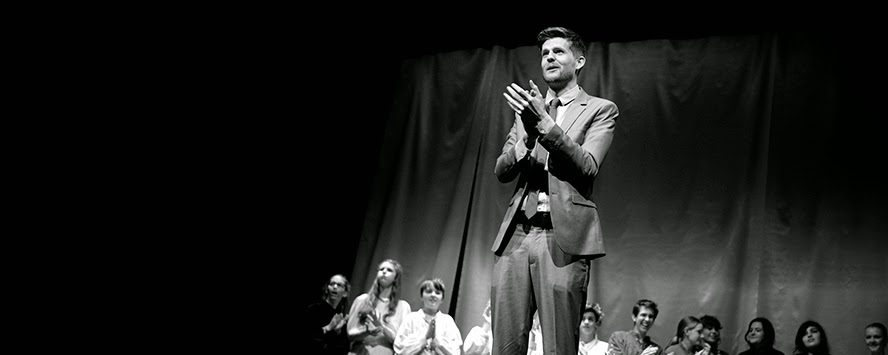"I’m not a
dancer but that doesn’t stop me dancing."
A workshop for generating
movement and choreographies from a range of everyday movements and gestures.
Ideally you would take 2, if not 3
sessions to complete these activities and to repeat presentations but with
different music and in different styles allowing participants to experiment
with timing, tone, speed, intensity, etc.
Warm up 10 mins
✭ ‘Twisting wrists’
Starting with arms outstretched in front, curl the fingers
in. Slowly add in body parts while continuing to twist and articulate previous
parts. Once the whole body is twisting and walking bring the warm-up to a
close.
✭ ‘Kittens fighting’
In pairs. The kittens have to try to softly touch their
partner on different parts of their body, while trying not to be touched
themselves. Remind participants that kittens have very soft paws, also that
they need to keep an awareness of others around them at all times. This
emphasis of this activity is on warm-up and building a good pair/group dynamic,
not on competition.
Group choreography from sport 40 mins
✭ Individually, select 5 short movements from sport. These
can be from the same or from different sports. After selecting the 5 movement,
‘abstractify’ each by changing one element of the movement to make it less
recognisable and more ‘dancey’. No need to order them.
✭ After developing the 5 movements, select the best 2. In
pairs, teach each other the 2 moves.
✭ Pairs meet pairs, teach each other the 4 moves.
✭ The groups of four order the movements and make a routine
that lasts 4 counts of 8. The routine should be easily repeatable, even if this
means adding in a count of 8 to walk back to the starting position.
Optional-
one movement must last for 8 beats, and one movement must last for 2 beats.
Presentation 1 15 mins
✭ Present the dances but with different styles/moods of
music. Students have to work with or against the music, but maintain group
timing.
✭ If given more time, the presentation of this exercise works
best when combined with solos and students present with a group space and solo
space, like in the following activity.
Solo and group dances combined 60 mins (minimum)
✭ As a whole group, in a clearly visible place write a 10
point list short of gestures/movements.
e.g. 1. Turn head
2. Raise hand
3. Put head in hands
4. Smile
5. Stand up/Sit down
6. Move behind a chair
7. Put your hand on someone’s face
8. Close eyes
9. Cross/uncross arms/legs
10. Clench fists
✭ Set up a bench or a row of chairs for 3-5 people, on the
stage. During the presentation participants can choose and complete movements
from the list. There is no limit to how many times each movement is completed,
if at all. There are moments when a pause is also necessary and eye contact can
be key. Except from a set action like a Smile, neutral faces is also necessary.
✭ For now though, put this exercise on hold before presenting
to work on the solos.
✭ Give each participant a small piece of paper and a pencil
to write a directive for a dance or movement solo. Participants choose one of
two options:
- Write a well-known body related metaphor or figure of
speech
e.g. My heart is breaking
My
legs have turned to jelly
Keep
your chin up
A
pain in the neck
Butterflies
in my stomach
I’m
head over heels
I
have a fire in my belly
Brain
Freeze
There’s
a thorn in my side
etc...
or
- Write a short description of nature or otherwise
e.g. Butterflies in grass
Water
rushing over a waterfall
Spinning
endlessly through Space
Being
kissed all over
The
building of Mt. Everest
Lava
bubbling and then cooling
etc…
✭ It may be useful to remind
participants that they are writing a gift for another, and that the receiver of
their directive should be inspired but not restricted by it.
✭ After writing, in a circle everybody passes their paper to
the right. Give participants a few minutes to try out their new directive. The
emphasis of this is not on developing a literal/mimic representation so the audience are able to understand what
the directive said, but on finding an abstract representation of it, that
captures some of the essence or feeling of the directive, but is not necessarily
easily recognisable.
✭ Now prepare the performance space. Define a group and a
solo area like this:
Presenters start in the group area and complete gestures from
the 10 point list (as above). This continues throughout the presentation
(usually the length of a song). At any time though, a single presenter can move
to the solo area and present their solo representation of their directive, for
as long or as short as they feel necessary. When they have finished their solo,
they can return to the group area and resume their gesturing.






